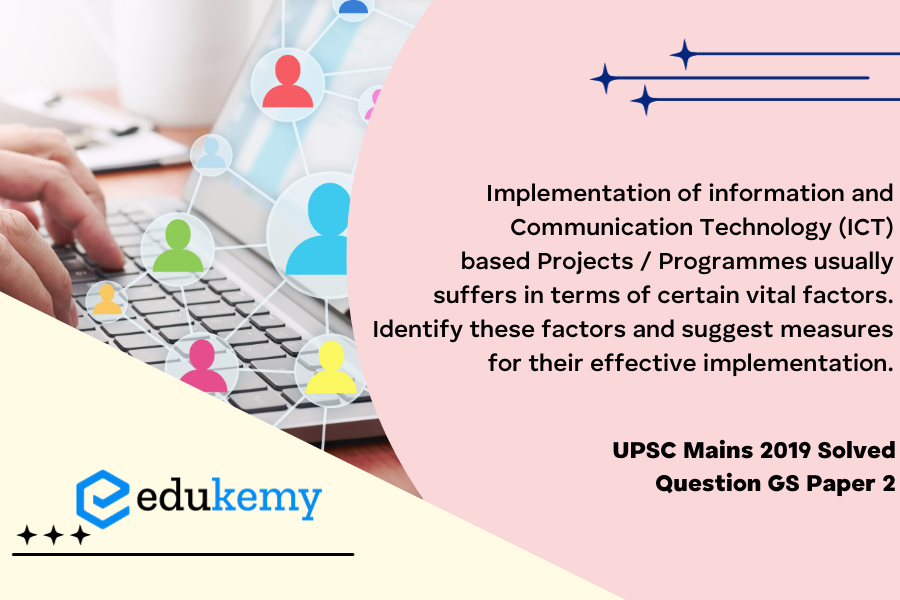The implementation of Information and Communication Technology (ICT) based projects/programmes is often confronted with challenges that hinder their success and efficiency. One crucial factor impeding effective implementation is inadequate infrastructure. A lack of robust technological foundations, including reliable internet connectivity and hardware resources, can significantly hamper the seamless execution of ICT projects. Moreover, insufficient technical expertise among the workforce poses another hurdle, as the successful integration and operation of advanced technologies demand skilled personnel. Furthermore, financial constraints emerge as a pervasive obstacle, limiting the allocation of necessary funds for acquiring state-of-the-art technologies and maintaining them over time.
Tag: e-Governance.
Contents
Decoding the Question:
- In Introduction, try to briefly write about the importance of Information and Communication Technologies.
- In Body,
- Explain various challenges in implementing ICT in India.
- Suggest some measures to address challenges.
- In Conclusion, can write about the overall significance of ICT-based programs and mention government steps.
Answer:
Misgovernance has been a major issue that has marred the effective implementation of government schemes and policies. Therefore, the government has been spearheading radical digitization to induce economic inclusiveness and social transformation, through initiatives like, ‘Digital India’, ‘Make in India’, and Skill India. It helps in the effective implementation of policies when coupled with social sector development projects, service delivery to the public, and public infrastructure development.
Challenges in implementing ICT in India and measures that can be taken:
- Different Language: In India, the diversity of people in the context of language is a huge challenge for implementing e-Governance projects as e-Governance applications are written in the English language. The government can introduce multi-language applications.
- Low digital literacy: The illiteracy rate in India is more than 25-30% and digital literacy is almost non-existent among more than 90% of India’s population.
- Poor internet connectivity: Rural India suffers from poor internet penetration due to a lack of electricity and poor network quality. This has led to difficulties in Aadhaar Enabled Payment Services (AEPS) and last-mile delivery of services.
- Non-inclusive: The nature of technology is not friendly for senior citizens, differently-abled, illiterate persons due to the complex design of ICT-based solutions.
- Geographical barriers: There is a lack of connectivity in remote areas and difficult terrains like North-eastern states, Andaman and Nicobar, etc.
- Problems in Common Service Centres: Lack of proper infrastructure facilities, unavailability of skilled workforce, huge population to serve, and unavailability of last-mile connectivity are some common issues faced by CSCs in India.
- Errors and Omissions in technology implemented: Issues related to identity mismatch and denial of services to beneficiaries. For. ex: cases where senior citizens have been denied ration via PDS shops due to fingerprint mismatch.
- Cost: In developing countries like India, the cost is one of the most important obstacles in the path of implementation of e-Governance where a major part of the population is living below the poverty line.
- Privacy concerns: Programme implementation using digital technology requires authorization for the collection and usage of public information at a large scale. Since, privacy being a fundamental right, there are concerns related to the mishandling and misuse of user information.
- Data theft and online security: Cyber security issues like cyber attacks, data theft can cripple sensitive government digital infrastructure like servers, power supply, communication links, etc.

Measures to Address Challenges:
- The government can generate awareness, promote digital literacy, and simplify the digital interface to increase the use of e-governance.
- There is a need to focus more on creating digital infrastructure to reduce cost and increase internet penetration.
- Increasing the number of Common Services Centres and addressing the connectivity issues should be the priority.
- Corporations can be asked to spend their CSR funds in digital training and providing technological solutions for societal needs.
- The capacity building, training, and interoperability among various departments and organizations can strengthen e-governance.
- By including civil society and the private sector, organizations and governments can create more robust ICT platforms.
- The participation of people along with government initiatives can play a vital role in the implementation of e-Governance in India.
Even though there are several challenges in the effective implementation of such programs, the benefits of ICT-based solutions cannot be neglected. It helped to save revenue for the exchequer by plugging leakages, weeding out ghost beneficiaries, targeted delivery of services in real-time, etc. It has improved transparency, accountability and last-mile delivery of basic services to the citizens. The government is making many efforts like the Digital India mission, Pradhan Mantri Gramin Digital Saksharta Abhiyan (PMGDISHA), Digital locker, etc., to address the challenges of ICT- programs.
In case you still have your doubts, contact us on 9811333901.
For UPSC Prelims Resources, Click here
For Daily Updates and Study Material:
Join our Telegram Channel – Edukemy for IAS
- 1. Learn through Videos – here
- 2. Be Exam Ready by Practicing Daily MCQs – here
- 3. Daily Newsletter – Get all your Current Affairs Covered – here
- 4. Mains Answer Writing Practice – here


